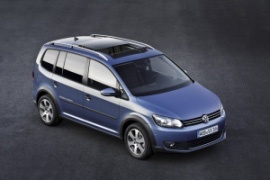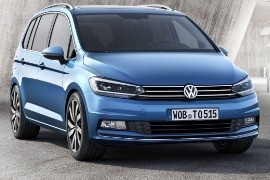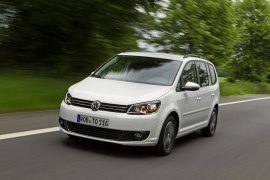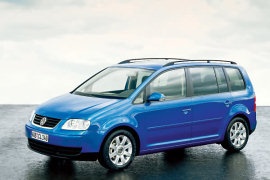
VOLKSWAGEN Touran
Generations Timeline, Specs and Pictures

Volkswagen introduced the Touran MPV in 2003 on the same platform as the Golf V and introduced two facelift versions and the crossover-style CrossTouran in 2011.
After successfully introduced two other crossover-style vehicles, the Polo and the Golf Plus, Volkswagen raised the stakes and included a Cross package for the Touran MPV in 2006. In 2011, it returned with the restyled version of the compact MPV.
While the French carmakers were the segment leaders, Volkswagen tried hard to catch-up and offer family-oriented vehicles fit for long trips and big loads. The Golf MKV platform was one of the best on the market, and that convinced the carmaker to use it when it designed the CrossTouran. It had the same underpinnings as the CrossGolf Plus, and thus, it was easier to make it happened. The 2010 Touran already had the new headlights that resembled those installed on the Golf VI, and that made it less bland. In the Cross trim-level, the carmaker added plastic moldings on the wheel arches and supplementary protections on the lower side of the bodywork.
Inside, the CrossTouran featured a specific upholstery, which came as a package with the leather-wrapped steering wheel and gear-stick. The dashboard design was the same as the one installed in the regular Touran, which was different than the one from the regular Golf. Inside the instrument cluster, the carmaker installed two big dials for the speedometer and tachometer and smaller gauges at their bottom for fuel-level and coolant-temperature.
Under the hood, the CrossTouran received a range of new, downsized engines, but more powerful, thanks to the turbochargers technology. The base version featured a 1.6-liter turbo-diesel unit, while the sportiest version received a 1.4-liter turbocharged gasoline engine.

The third generation of the Touran was introduced at the 2015 Geneva Motor Show.
The MPV was more stylish than before and it featured more comfort and safety amenities.
Like most of the Volkswagen range, the Touran was developed on the MQB platform. It was fitted with an automatic post-collision braking system, adaptive cruise control, and city emergency braking. It also featured pre-crash proactive protection, side assist, and rear traffic alert.
From the design point of view, the Touran featured a grille inspired by its three-box sibling, the Jetta. With its chromed longitudinal lines which were stretched from one headlight to another, it made the MPV look wider. The Touran was fit between the Golf Plus and the Sharan.
Inside, there was room for seven passengers with seven individual seats in the middle row, which could slide and tilt. The last row was fit for children. When folded, the second and third-row made a flat platform that expanded the trunk space. The dashboard was minimalist, in the Volkswagen style. The infotainment system supported Apple CarPlay and Android Auto connectivity.
For the drivetrain, the Touran was offered with a choice of three versions of turbodiesels and three turbocharged gasoline units. Most versions came mated as standard with a 6-speed manual, while for the top versions (one diesel and one gasoline) a 7-Speed DSG (dual-clutch system) was fitted as standard.

Volkswagen introduced the 2010 Touran seven-seater MPV based on the same platform as the Golf VI and continued the saga of the successful compact German minivan.
Even though the European MPV market was not even close to the hatchback segment in terms of volumes, Volkswagen charged with the Touran since 2003, trying to catch the French and Italian carmakers. The Germans won on their home-ground and managed to sell 1.13 million units from the first Touran generation. With the 2010 model, they pushed forward with a new generation, based on a new platform and new powerplants.
With a front fascia that resembled the Golf, Touran featured angular headlights and a chromed, two-slat grille. Its wrapped-around bumper sported a pair of fog lights and a broad grille between them. The short and steep hood was continued by an even steeper windshield that started the tall greenhouse’s shape. At the back, the carmaker made a vertical drop for the tailgate, with horizontal taillights.
Inside, the carmaker installed high-mounted seats with room for seven people. The flat-folding rear seats and the folding middle row increased the trunk size up to 1,989 liters (67.6 cu-ft) of space in the five-seat configuration and the removed second row. Even the right passenger’s seat featured a folding seatback for longer loads. On the other hand, with all the seats in place, it could hold just 137 liters (4.8 cu-ft) of luggage. Starting with the 2010 model, Volkswagen introduced a new RNS 315 touch-screen infotainment system on the Touran.
The 2010 Touran joined the downsizing trend and introduced a 1.2-liter turbocharged gasoline engine and a 1.6-liter TDI unit. Power ranged between 90 hp and 170 hp, and either a six-speed manual or a seven-speed automatic were on the offer.

Volkswagen used the Golf’s MK5 platform to build the Touran minivan in 2003 and improved the vehicle with a facelifted version in 2006.
While Renault was the strongest competitor in the European minivan market, Volkswagen didn’t want to lose a share of that pie. To make things easier, it didn’t start the project from scratch and used the Golf MK5 platform to create an MPV, following the same recipe used by Renault for the Scenic and Opel/Vauxhall for the Zafira.
For the 2006 model, the Touran featured new headlights with a similar design as the Polo, with a chromed surrounding. Its grille was also enhanced with a shiny rim. The bumper featured an updated design with a wider dam on the lower side and a body-colored apron. At the rear, the 2006 Touran featured slightly redesigned taillights but with the same shape.
Inside, the Touran offered room for seven, albeit the last two seats were adequate only for children due to the lack of legroom. The customers could have folded down both the middle and the last row of seats to expand the trunk size, but they were not removable. Volkswagen added curtain airbags for the first two rows in terms of safety, complementing the front dual-airbag and side airbags. The Isofix anchoring points for child seats were standard on the second row. The carmaker installed the ParkAssist system, which controlled the steering wheel to ease the parking maneuvers.
Under the hood, Volkswagen installed a choice of seven engines for most markets and added a CNG version for selected countries.

The CrossTouran is another member of the Cross family which belongs to Volkswagen and which also includes CrossPolo and CrossGolf.
The new rugged version of the popular van was first unveiled at the 30th edition of the Bologna Motor Show and was launched on the European market in the spring of 2007. The car was available in three engine version powered by gasoline and three TDIs which could produce from 102 to 170 horsepower. Based on the standard Touran, the CrossTouran differentiates through a higher ground clearance and the addition of plastic cladding on the lower body and wheel arches.

Volkswagen decided to enter the competition on the minivan market with a vehicle built on top of a trusted platform carried over from its hatchback sibling, the Golf.
In 2003, Renault, Citroen, Opel/Vauxhall, Fiat, and Ford contested the top spot in the European minivan market. It wasn’t easy for Volkswagen to keep up with its main rivals in a segment where the price was critical, but the carmaker tried a different approach.
While other carmakers invested more time and money in the design department, Volkswagen went for the form-follow-function concept and built a vehicle with a rather dull design. Even though it didn’t have the same appeal as the others, it convinced its customers with its safety features, the five-star EuroNCAP results, and a trustworthy engine lineup. At the front, it installed a chromed trim on the lower side of the grille and a set of clear-lens headlights, which featured four individual lamps inside, including an option for Xenon.
The interior was very roomy and practical and, due to its large windows, offered a fish-tank experience for its seven occupants. It provided many storage areas on the door cards, ceiling, and center console. The last row of seats folded neatly into the trunk area, increasing the luggage compartment up to 695 liters (24.5 cu-ft), but with all seats up, that volume space tumbled to just 121 liters (4.3 cu-ft).
Under the hood, Volkswagen offered a choice of ten engines, both gasoline, and turbo-diesel. For fleets, the carmaker added a CNG version.























































